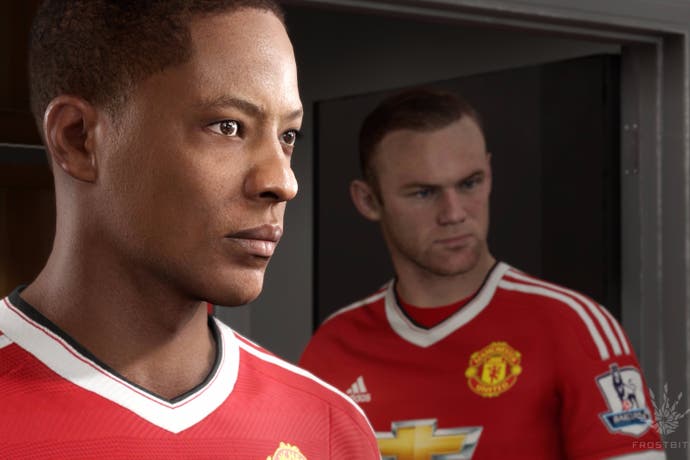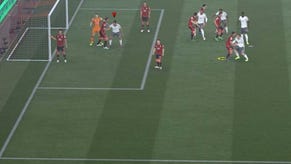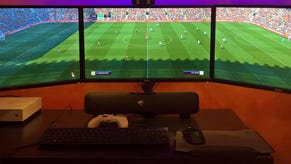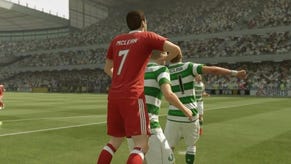FIFA 17 has a story mode with a Mass Effect-style dialogue wheel
The Illusive Man-on.
The new FIFA has a story mode that lets you use a Mass Effect-style dialogue wheel.
FIFA 17's story mode, called The Journey, sees you assume direct control over Alex Hunter, a young footballer who has just signed for a Premier League club.
Hunter, a character inspired by the likes of Raheem Sterling and Andros Townsend, is thrust into the first team and finds himself in the same dressing room as superstar footballers.
At a recent hands-on event, I got to play this scene. In the demo provided by EA, Hunter had signed for Manchester United. We see him and close friend Gareth Walker, who has also signed for Man Utd, looking agog at their names on their shirts in the dressing room. They're proud, excited and scared.
The pair prepare to make their debut. During the pre-match team talk, the no-nonsense coach Butler explains the importance of the match - away at bitter rival Liverpool. Manchester United's German midfielder Bastian Schweinsteiger is milling about. It's clear the developers are trying to make the player feel like FIFA 17's story is an authentic one, a fusion of the real world and the virtual.
Coach Butler reveals Man Utd's first 11 for the match: Hunter is on the bench, Walker is set to play up front. It's a huge moment for both players. Gareth sits next to Alex, preparing himself mentally to make his debut. Then, the cutscene pauses and a conversation wheel pops up at the bottom of the screen, as it does in Bioware's Mass Effect. Your dialogue choices fall into three rough categories: arrogant, calm, and team player. I picked the arrogant dialogue choice: "Score a goal for me!" Alex proclaims. Gareth doesn't react well, standing up to walk out onto the pitch alongside his teammates without saying a word. Alex seems upset that his friend ignored him.
We're pitch-side, and Alex takes his seat on the substitutes bench. We see key points of the match play out from a cinematic perspective: Gareth Walker scores to put Man Utd one up, and Alex is delighted for his friend, clapping and smiling on the sidelines. But Daniel Sturridge equalises for Liverpool, setting up Alex Hunter for a dream debut.
We see United manager Jose Mourinho prowling the touchline, deep in conversation with Coach Butler. Then the call comes: Hunter is coming on with 15 minutes left. Time to warm up.

Hunter jogs along the touchline. We hear the Liverpool fans chant: "Who are ya?! Who are ya!" The commentators discuss the toughness of the task: what a time and what a place to make your debut. "Welcome to the Premier League!" they say.
Coach Butler tells Hunter to use his pace to cause Liverpool's tiring defenders problems. Then the game presents "objectives": obtain a 7.0 or above player rating; score a goal; win the match. Hunter comes on to make his debut, the commentators excited by United's new prospect.
This is where the cut-scene ends and the gameplay begins. The action is presented from the normal FIFA in-game camera viewpoint, but you're in control of just one player: Alex Hunter. I spent a lot of time watching the radar at the bottom of the screen while trying to keep Hunter in position as the ball - and the camera - shifted around the pitch. With the computer controlling my teammates, I struggled at first, relying on United's midfielders to win the ball before passing to me. I successfully completed a few passes, keeping an eye on my player rating at the top right hand corner of the screen to see how I was doing. I managed to get a shot off that was blocked. 7.1 - keep trying, FIFA 17 told me. Progress, then.
With time running out, I hit the bar. Then I hit the bar again. The ref blew the whistle, and the game ended 1-1. A frustrating debut, then, but I did manage to achieve a 7.3 player rating, completing my first objective. I had failed the other two, though: I didn't score, and we didn't win.
We then move onto the post-match interview. Here, Hunter is asked about the team's performance and once again the Mass Effect-style dialogue wheel appears on-screen, and once again again three options present themselves: team player, calm, or arrogant. And once again, I went for the arrogant choice: "I always give my team a chance to win," Hunter says.
Here's where the demo ended. My snippet of FIFA 17's story mode was a bizarre experience, and nothing like I've ever played in a FIFA game before, which, I suppose, is a good thing for a series that's often accused of failing to innovate year on year. But I can't help but feel the addition of a story mode has more to do with appealing to those who perhaps do not play FIFA, or perhaps used to but dropped off the radar, rather than attracting the series' gargantuan core players over from modes such as FIFA Ultimate Team and Online seasons.

Senior producer Nick Channon told me story mode is something FIFA players have been calling for for some time, which comes as some surprise to me.
"People wanted to see a little bit more beyond the pitch," he says.
"We looked at the game itself and where could we improve, and what could we add? And we felt it was a good time to add new major mode. We felt narrative story was something that had been missing."
So why now? Story mode was enabled by FIFA's switch from the Ignite engine to the Frostbite engine, Channon says. FIFA 17 is the first game in the franchise to use the game engine built by DICE to power Battlefield. But the shift makes sense: FIFA on Ignite had started to show its age, and with pretty much every EA-published game using Frostbite now, including Bioware for the likes of Dragon Age and Mass Effect, moving to a new technology base allows the FIFA developers to collaborate with other studios at the mega publisher in a much deeper way than previously possible.
And that's what they've done: Channon says the FIFA developers have worked with Bioware and DICE for certain aspects of FIFA 17. The obvious point of collaboration was with Bioware for the dialogue wheel, the story and the cutscenes, but they also worked with DICE on the graphics.
For example, FIFA 17 takes advantage of Frostbite's superior lighting technology for matches played at night-time. But we also see improved player faces. Channon says the tech means the developers can animate the flesh on faces, which sounds like a disgusting job but someone's got to do it. You'll also notice all the players have glassy eyes, or, as I first thought, galaxies for eyes. It's a tad distracting, to be honest. I think developers still haven't worked out how to make realistic video game character eyes.
I get the impression The Journey will be somewhat limited in terms of length. Channon wouldn't be drawn on how much of young Alex Hunter's career it takes in, but I suspect we'll get his first season at least. I can't see it telling the story of his entire football career. We can, though, level Alex up to a degree. The Journey includes trait points, which you can spend to upgrade traits such as a power header. You can also spend time in a training mode to improve his stats and shape him as a player, perhaps working on finishing or on passing.
Still, I suspect The Journey will be limited in terms of its capacity to react to player decisions. Channon tells me Hunter's personality trait will change depending on your dialogue choices, but I'm not sure how this will manifest itself in the story. There's a social media feed where famous players (Arsenal and France striker Olivier Giroud is one I spotted) tweet Hunter, wishing him well. Apparently the text here changes depending on your dialogue choices. But let's be clear: FIFA 17's story mode is not Mass Effect meets football.
Where there's scope for a more reactive experience is in player performance, and this is where The Journey could get interesting. Channon says your performance on the pitch changes the story in significant ways. The first example of this happens as you look to sign for a Premier League club - your performance level determines who expresses interest. But there's more to it: Channon says if you get a red card Alex will have to explain himself in Coach Butler's office.
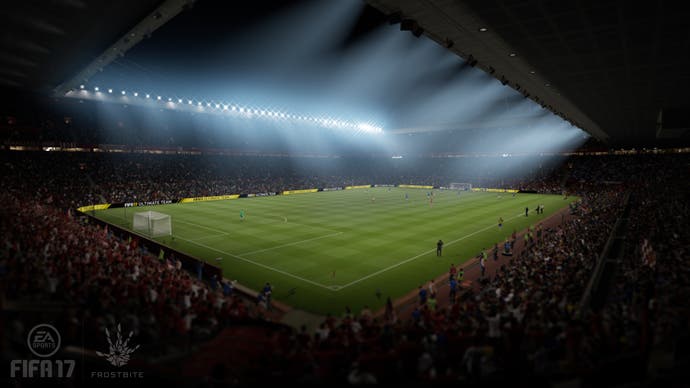
How bad can things get for poor Alex? Well, if you play terribly and fail to hit your objectives, you will be sent out on loan. This triggers another cutscene that involves a dialogue wheel choice. Here, Alex is sat in his room, upset that Manchester United are shipping him out to a club in The Championship. His grandfather walks in reassure young Alex. "David Beckham went out on loan to Preston and it was the making of him," the grandfather says. Then, Alex gets a call. It's a mate who tells him to put on "Sports News". On the telly we see Spurs and England striker Harry Kane tell reporters how excited he is to have signed for Manchester United and to be playing up front with Alex's good friend, Gareth Walker. (EA actually motion-captured Harry Kane's face and recorded voice over for this scene). Alex is fuming. He feels like he's being replaced.
Then the dialogue wheel: in the demo I saw, Hunter tells his mate that he'll show everyone what he can do. His friend on the phone comments: "Fighting talk, I like it." And the scene ends.
The Journey's Alex Hunter reminds me a lot of current, real-life footballer Marcus Rashford (it turns out Rashford consulted on the story). Both are teenagers who burst onto the Premier League scene. Marcus is from south Manchester, and while EA doesn't reveal where Alex is from, we catch a glimpse of the Hunter family home: a terraced house somewhere in England with a small garden and an even smaller goal he obviously spent years kicking a ball into as a kid. It's a classic rags to riches football story, the local lad done good. In the real world, Rashford is heading to the Euros with England. Perhaps The Journey ends with an England call up for Hunter (he won't play at the Euros, of course, as Konami has that license for PES). Or perhaps Hunter spends the rest of his playing days eeking out a career in The Championship. YOU DECIDE.
So, The Journey is a curious, often bizarre, kinda funny, kinda cool mode for FIFA 17 that I suspect will be good for a laugh. But the main draw for FIFA 17 will be the changes made to gameplay. And it's here that I'm most excited.
The move to Frostbite has prompted some much-needed gameplay changes. All the set-pieces have been reworked. Corners now task the attacker with using the left thumbstick to move a tiny reticule about inside the box. Then you press a button to send the corner over.
It's a cool change. Corners would always frustrate me because they felt like a lottery. You'd angle the corner, press cross then hammer the shoot button. Maybe you scored. Maybe you didn't. If you scored a corner you weren't thrilled. If your opponent scored a corner against you it felt cheap. Now, at least there's some skill to the set piece. And there's some neat variety, too. In my handful of games I had a lot of fun targeting a near-post flick-on. Expect a lot of that online when the game goes live.
The set-piece changes extend to everything from throw-ins (which now let you move up and down the touchline before the throw), to free kicks (the camera now sticks behind the free kick taker after the ball is kicked so you can track its trajectory) to penalties (which now let you move about on the run up). It's a lot of little, much-needed improvements that all went down well during my hands-on.
Elsewhere, EA has added a new physical play system designed to improve your ability to shield the ball. Now, you hold the left trigger to tell the game you're being physical. You can do this in any situation. So, you lump the ball up to your striker, you can hold the left trigger to position your player to bring the ball down, rather than go up for a header, which is how previous FIFA games work. You can use left trigger to push back against a defender, or, as a defender, push back against an attacker. It's done pretty well, and looks realistic.
You can also use the new physical button to collide with the goalkeeper as they're catching the ball. This is a lot of fun. But you run the risk of getting a card from the ref. Worth it, though!
And here's another eye-catching change: to hit a low shot you need to power up the shot then press the shoot button again, before the player kicks the ball. In previous FIFA games you would power up the shot and the game would work out whether it was hit high or low, depending on the context of the situation. Now you can go for a low shot, which is great for scoring those angled drives into the bottom corner you see so often in real football. This works for headers, too, which you can now aim down.
You can see what EA's going for here: FIFA's first outing on Frostbite provides the developers with an opportunity to re-do some of the mechanics that haven't been significantly changed in years. Mechanics such as corners, penalties, jostling, first touch, runs and shooting - on their own these changes won't set the world on fire, but combined they should please most FIFA players.
The bigger picture is that with the move to a new engine, FIFA now has a solid foundation for the next decade of development. Frostbite is platform for the future, a platform that will power even more realistic flesh in Juan Mata's face, and even more glassiness in Wayne Rooney's eyes. That's the Battlefield effect.
As for the dialogue wheel, well, I doubt that will have a massive effect.
